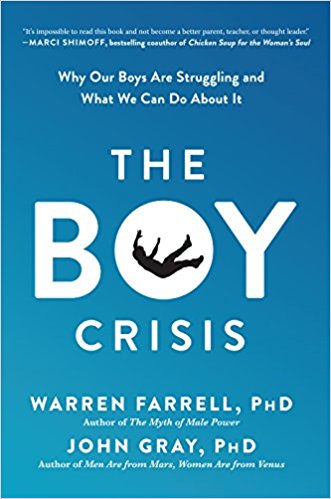
We’re missing a major mental health crisis: Teen boys are struggling, too
The Washington Post, by Jennifer Fink, April 14, 2023
Sheila Hedstrom-Pelger, a nurse in Chandler, Ariz., thought she knew the signs of depression. She had sought professional help for her oldest son, Alex, when he admitted feelings of hopelessness, sadness, anxiety and suicidal thoughts while in high school. But when her second son, Tyler, started verbally lashing out at her when he was a teen, Hedstrom-Pelger didn’t consider depression as a possible cause for Tyler’s out-of-character behavior.
“I took it personally,” she said. “I assumed he was upset with me.”
Only after Tyler’s suicide at age 17 did Hedstrom-Pelger learn that “irritability is a sign of depression and anxiety” for many males, “not just a ‘boy being a boy’ or ‘being a teenager,’” she said.
Being male is the biggest risk factor for suicide, yet that fact isn’t widely known, says Richard V. Reeves, author of “Of Boys And Men: Why the Modern Male is Struggling, Why It Matters, and What To Do About It” and a senior fellow in economic studies at the Brookings Institution. In the United States, nearly four times as many males die of suicide than females, according to the American Foundation for Suicide Prevention. Advertisement
“I have been quite shocked by people’s lack of awareness of this problem,” Reeves said. “I’ve encountered people in very senior positions, including a professor who spoke on a panel about teen mental health and suicide, who don’t know about the gender gap in suicide. I’ve had members of Congress tell me I’ve got this the wrong away around.”
Such confusion is understandable given the recent 2021 Youth Risk Behavior Survey (YRBS), which showed that girls are faring worse than boys across nearly all reported measures related to mental health challenges, experiences of violence, and suicidal thoughts and behaviors. Girls are certainly suffering to a very dark degree. But at the same time, boys are also not faring well.
Teenage boys, in particular, are experiencing high levels of mental distress. The CDC’s 2021 National Vital Statistics System (NVSS) showed a massive increase in male suicide among teens and young men. From 2020 to 2021, suicide rates for males rose significantly, according to the CDC, with the largest increase among males ages 15 to 24. Among this group, the suicide rate was up 8 percent in 2021 over 2020.
Reeves believes we could benefit from currently nonexistent research or governmental organizations whose “job it is to draw attention to the problems of boys and men.” (Washington state recently filed a bill that would create a government commission on boys and men.) He believes the lack of research contributes to our lack of understanding of male distress and depression.
But even more, experts also believe the increase in suicide comes down to how we misunderstand how societal expectations affect boys’ well-being and emotional expression.
“Boys’ human development has been compromised by the boyhood that we have built and managed for them for generations,” said Michael C. Reichert, founding director of the Center for the Study of Boys’ and Girls’ Lives at the University of Pennsylvania and author of “How to Raise a Boy: The Power of Connection to Build Good Men.” Common societal expectations — that boys should be strong and independent, for example — hamper boys’ ability to acknowledge emotions and ask for help.
“Boys are conditioned not to ask for help, to not express their emotions,” said Stacey Freedenthal, licensed clinical social worker and author of “Loving Someone with Suicidal Thoughts: What Family, Friends, and Partners Can Say and Do.” This conditioning means that many boys and young men are unlikely to say when they are feeling sad.
Because they are conditioned to not express sadness, boys and men experiencing depression may exhibit it through anger, aggression and irritability, fatigue, and loss of interest in school or hobbies, according to the National Institute of Mental Health. The 2021 YRBS asked about “sad feelings” and hopelessness, but didn’t ask about anger or irritability, which may be why the survey detected high levels of female depression and missed boys’ despair.
“There is some evidence that we might be under-detecting depression in men due to the questions we ask,” Reeves said.
Tyler’s mom, Hedstrom-Pelger, said the symptoms he exhibited — withdrawal, irritability, a new circle of friends — were “not things I would’ve connected with depression and anxiety until after I learned more.” Now, she tells other parents, “If your kid lashes out at you, don’t be so quick to ground them or take their phone away. Let them walk away and a little bit later, check in and say, ‘What was that all about? Is something wrong?’”
Jayden, a 16-year-old who is active in Arizona Students for Mental Health, a nonprofit developed by students to address suicide and mental health, said that boys who are experiencing anxiety, depression or other mental health challenges “might not come right out and say, ‘I’m struggling.’” Instead, he said, they may withdraw or act uncharacteristically, like Hedstrom-Pelger’s son Tyler did.
Jayden’s feeling is not uncommon, Reichert said. Because society has long implied that boys and men should be strong and unemotional, many “guys keep things to themselves because they can’t find any other outlet.” That isolation seems to be a defining feature (and cause) of teen males’ distress. “The way the mental health problems of young men and young women present themselves is not just different but diametrically opposed,” Reeves said. “With girls, it’s their relationships and relationship to the world that can become so problematic. With boys, it’s retreat from the world and lack of relationships that’s the problem.”
Fifteen percent of young men today don’t have a close friend, according to the American Perspectives Survey, and many young men ages 18 to 23 feel that “nobody really knows me,” according to research Reichert is conducting. This lack of connection may explain why so many boys are struggling silently.
“We’ve had 70 suicides in five years,” said Katey McPherson, an educational consultant who’s been tracking teen suicides in Phoenix’s East Valley, a 15-to-20-square-mile area, since 2015. “Of those, I’d say 90 percent of them were boys.”
John Sefcik, a 30-year-old licensed associate counselor working in a Monmouth, N.J., high school, said students routinely ask him to check on friends they are worried about. But he also said that those who seek his help have “skewed far more heavily toward girls reaching out with concern about other girls. I can’t think of a single boy who’s come in concerned about another boy.”
Despite the persistent threats to male mental health, Reichert believes “there’s never been a better time to be raising a boy.”
“We’ve finally broken through the taboo and allowed ourselves to question why we’re doing what we’re doing if it’s not working,” he said. Boys, just like girls and nonbinary children, need care, compassion and validation.
Awareness of boys’ mental health needs is step one to arresting the male suicide crisis. “Parents need to know that being male is the biggest risk factor for suicide,” Reeves said. “The chances of your son taking his life by suicide are about four times higher than your daughter’s.”
Delighting in our boys is the next (and perhaps most essential) step, Reichert said. Instead of focusing on our boys’ behaviors and flaws, he encourages parents to “find a way through all the insecurities, doubts and worries you have and locate the place in your heart where you can be delighted with your son.” Spend dedicated time with him, doing what he likes, without lecturing, scolding, or coercing.
“Parents have an enormous power to validate their son’s existence,” Reichert said. Delight is “like sunlight to a young man. The more you beam it toward him, the more he’s going to feel safe and the more likely he’ll be to open up to you.”
Remove firearms to decrease suicide risk
Another reason boys’ suicide rates are higher than girls’ may be because males are generally more impulsive than females, particularly as adolescents.
“Boys tend to mature and develop at a slower rate than girls,” said Freedenthal.
Boys also tend to choose more violent and lethal methods of suicide than girls do.
Removing firearms from your home can dramatically reduce suicide risk. According to the American Foundation for Suicide Prevention, “most people in suicidal crisis who don’t have easy access to a lethal suicide method will not simply find another way to kill themselves.”
Locking up guns is not as protective as removing them from the home, Freedenthal said, as motivated teenagers can figure out how to get past locks.
Contact
Contact WHCBM Steering Committee:
Coalition Chair: Dr. Warren Farrell - warren@warrenfarrell.com
Please Donate!
Your donations to the work of the Coalition to Create a White House Council on Boys and Men through PayPal and Network for Good are processed by our parent 501(c)(3) non-profit association, the Global Initiative for Boys and Men.
Paypal:
You can also become a Patron through Patreon.
Become a Patron!
Sign up for our newsletter, The Proposal.

A silent crisis in men’s health gets worse
Across the life span -- from infancy to the teen years, midlife and old age -- boys and men are more likely to die than girls and women
The Washington Post, April 17, 2023
A silent crisis in men’s health is shortening the life spans of fathers, husbands, brothers and sons.
For years, the conventional wisdom has been that a lack of sex-specific health research mainly hurts women and gender minorities. While those concerns are real, a closer look at longevity data tells a more complicated story.
Across the life span — from infancy to the teen years, midlife and old age — the risk of death at every age is higher for boys and men than for girls and women.
The result is a growing longevity gap between men and women. In the United States, life expectancy in 2021 was 79.1 years for women and 73.2 years for men. That 5.9-year difference is the largest gap in a quarter-century. (The data aren’t parsed to include differences among nonbinary and trans people.)
The longevity gap between men and women is a global phenomenon, although sex differences and data on the ages of greatest risk vary around the world and are influenced by cultural norms, record keeping and geopolitical factors such as war, climate change and poverty.
The Boy Crisis: Why Our Boys Are Struggling and What We Can Do About It.


WHAT IS THE BOY CRISIS?
It’s a crisis of education. Worldwide, boys are 50 percent less likely than girls to meet basic proficiency in reading, math, and science.
It’s a crisis of mental health. ADHD is on the rise. And as boys become young men, their suicide rates go from equal to girls to six times that of young women.
It’s a crisis of fathering. Boys are growing up with less-involved fathers and are more likely to drop out of school, drink, do drugs, become delinquent, and end up in prison.
It’s a crisis of purpose. Boys’ old sense of purpose—being a warrior, a leader, or a sole breadwinner—is fading. Many bright boys are experiencing a “purpose void,” feeling alienated, withdrawn, and addicted to immediate gratification.
So, what is The Boy Crisis? A comprehensive blueprint for what parents, teachers, and policymakers can do to help our sons become happier, healthier men and fathers and leaders worthy of our respect.

